Cultural Consumer Behavior: A Comparative Study of China and Britain
VerifiedAdded on 2023/06/12
|18
|4510
|441
Report
AI Summary
This report examines the significant differences in consumer behavior between Chinese and British cultures, primarily through the lens of Hofstede's Cultural Dimensions model. It begins by defining consumer behavior and outlining the various social, psychological, personal, and cultural factors that influence it. The report then delves into Hofstede's model, exploring dimensions such as power distance, collectivism vs. individualism, uncertainty avoidance, masculinity vs. femininity, long-term orientation, and indulgence vs. restraint. Each dimension is analyzed in the context of both Chinese and British societies, highlighting how cultural values shape consumer preferences and purchasing decisions. The report also addresses the importance of language as a cultural factor, despite not being a formal dimension in Hofstede's model. Finally, the report applies these insights to a practical business scenario, suggesting how Eden Project management should adapt its marketing mix to effectively engage Chinese consumers, emphasizing product adaptation, promotion strategies, and the integration of cultural values into their business approach.
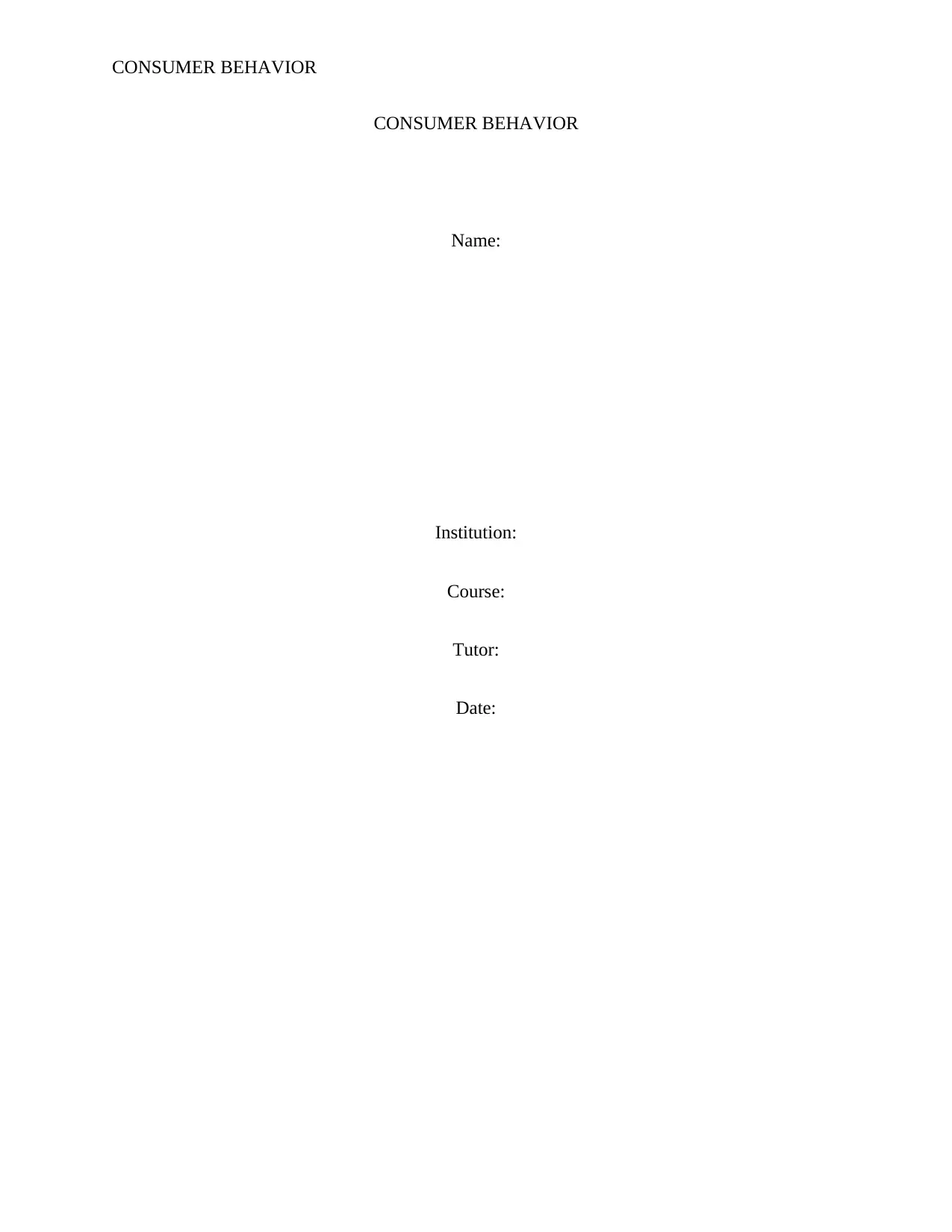
CONSUMER BEHAVIOR
CONSUMER BEHAVIOR
Name:
Institution:
Course:
Tutor:
Date:
CONSUMER BEHAVIOR
Name:
Institution:
Course:
Tutor:
Date:
Paraphrase This Document
Need a fresh take? Get an instant paraphrase of this document with our AI Paraphraser
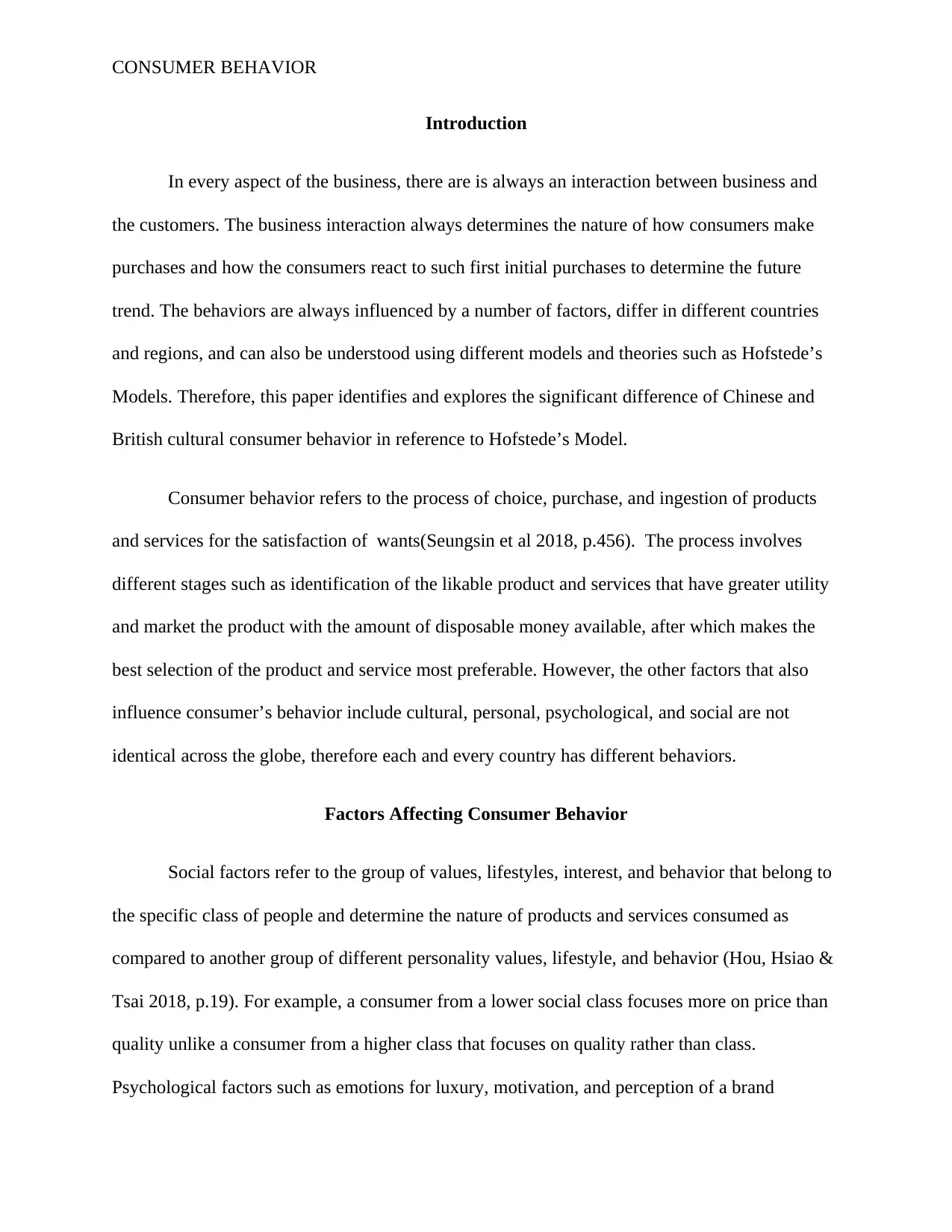
CONSUMER BEHAVIOR
Introduction
In every aspect of the business, there are is always an interaction between business and
the customers. The business interaction always determines the nature of how consumers make
purchases and how the consumers react to such first initial purchases to determine the future
trend. The behaviors are always influenced by a number of factors, differ in different countries
and regions, and can also be understood using different models and theories such as Hofstede’s
Models. Therefore, this paper identifies and explores the significant difference of Chinese and
British cultural consumer behavior in reference to Hofstede’s Model.
Consumer behavior refers to the process of choice, purchase, and ingestion of products
and services for the satisfaction of wants(Seungsin et al 2018, p.456). The process involves
different stages such as identification of the likable product and services that have greater utility
and market the product with the amount of disposable money available, after which makes the
best selection of the product and service most preferable. However, the other factors that also
influence consumer’s behavior include cultural, personal, psychological, and social are not
identical across the globe, therefore each and every country has different behaviors.
Factors Affecting Consumer Behavior
Social factors refer to the group of values, lifestyles, interest, and behavior that belong to
the specific class of people and determine the nature of products and services consumed as
compared to another group of different personality values, lifestyle, and behavior (Hou, Hsiao &
Tsai 2018, p.19). For example, a consumer from a lower social class focuses more on price than
quality unlike a consumer from a higher class that focuses on quality rather than class.
Psychological factors such as emotions for luxury, motivation, and perception of a brand
Introduction
In every aspect of the business, there are is always an interaction between business and
the customers. The business interaction always determines the nature of how consumers make
purchases and how the consumers react to such first initial purchases to determine the future
trend. The behaviors are always influenced by a number of factors, differ in different countries
and regions, and can also be understood using different models and theories such as Hofstede’s
Models. Therefore, this paper identifies and explores the significant difference of Chinese and
British cultural consumer behavior in reference to Hofstede’s Model.
Consumer behavior refers to the process of choice, purchase, and ingestion of products
and services for the satisfaction of wants(Seungsin et al 2018, p.456). The process involves
different stages such as identification of the likable product and services that have greater utility
and market the product with the amount of disposable money available, after which makes the
best selection of the product and service most preferable. However, the other factors that also
influence consumer’s behavior include cultural, personal, psychological, and social are not
identical across the globe, therefore each and every country has different behaviors.
Factors Affecting Consumer Behavior
Social factors refer to the group of values, lifestyles, interest, and behavior that belong to
the specific class of people and determine the nature of products and services consumed as
compared to another group of different personality values, lifestyle, and behavior (Hou, Hsiao &
Tsai 2018, p.19). For example, a consumer from a lower social class focuses more on price than
quality unlike a consumer from a higher class that focuses on quality rather than class.
Psychological factors such as emotions for luxury, motivation, and perception of a brand
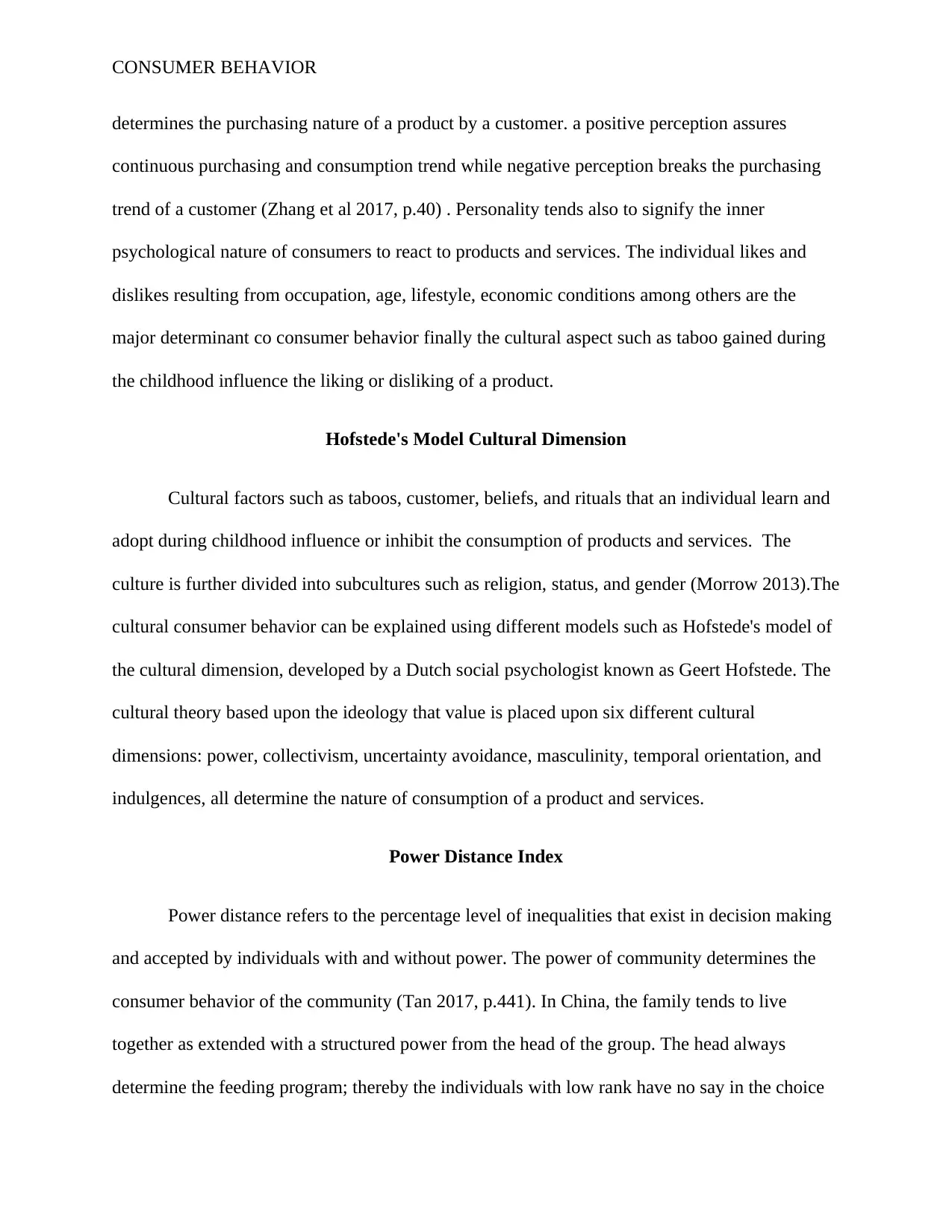
CONSUMER BEHAVIOR
determines the purchasing nature of a product by a customer. a positive perception assures
continuous purchasing and consumption trend while negative perception breaks the purchasing
trend of a customer (Zhang et al 2017, p.40) . Personality tends also to signify the inner
psychological nature of consumers to react to products and services. The individual likes and
dislikes resulting from occupation, age, lifestyle, economic conditions among others are the
major determinant co consumer behavior finally the cultural aspect such as taboo gained during
the childhood influence the liking or disliking of a product.
Hofstede's Model Cultural Dimension
Cultural factors such as taboos, customer, beliefs, and rituals that an individual learn and
adopt during childhood influence or inhibit the consumption of products and services. The
culture is further divided into subcultures such as religion, status, and gender (Morrow 2013).The
cultural consumer behavior can be explained using different models such as Hofstede's model of
the cultural dimension, developed by a Dutch social psychologist known as Geert Hofstede. The
cultural theory based upon the ideology that value is placed upon six different cultural
dimensions: power, collectivism, uncertainty avoidance, masculinity, temporal orientation, and
indulgences, all determine the nature of consumption of a product and services.
Power Distance Index
Power distance refers to the percentage level of inequalities that exist in decision making
and accepted by individuals with and without power. The power of community determines the
consumer behavior of the community (Tan 2017, p.441). In China, the family tends to live
together as extended with a structured power from the head of the group. The head always
determine the feeding program; thereby the individuals with low rank have no say in the choice
determines the purchasing nature of a product by a customer. a positive perception assures
continuous purchasing and consumption trend while negative perception breaks the purchasing
trend of a customer (Zhang et al 2017, p.40) . Personality tends also to signify the inner
psychological nature of consumers to react to products and services. The individual likes and
dislikes resulting from occupation, age, lifestyle, economic conditions among others are the
major determinant co consumer behavior finally the cultural aspect such as taboo gained during
the childhood influence the liking or disliking of a product.
Hofstede's Model Cultural Dimension
Cultural factors such as taboos, customer, beliefs, and rituals that an individual learn and
adopt during childhood influence or inhibit the consumption of products and services. The
culture is further divided into subcultures such as religion, status, and gender (Morrow 2013).The
cultural consumer behavior can be explained using different models such as Hofstede's model of
the cultural dimension, developed by a Dutch social psychologist known as Geert Hofstede. The
cultural theory based upon the ideology that value is placed upon six different cultural
dimensions: power, collectivism, uncertainty avoidance, masculinity, temporal orientation, and
indulgences, all determine the nature of consumption of a product and services.
Power Distance Index
Power distance refers to the percentage level of inequalities that exist in decision making
and accepted by individuals with and without power. The power of community determines the
consumer behavior of the community (Tan 2017, p.441). In China, the family tends to live
together as extended with a structured power from the head of the group. The head always
determine the feeding program; thereby the individuals with low rank have no say in the choice
⊘ This is a preview!⊘
Do you want full access?
Subscribe today to unlock all pages.

Trusted by 1+ million students worldwide
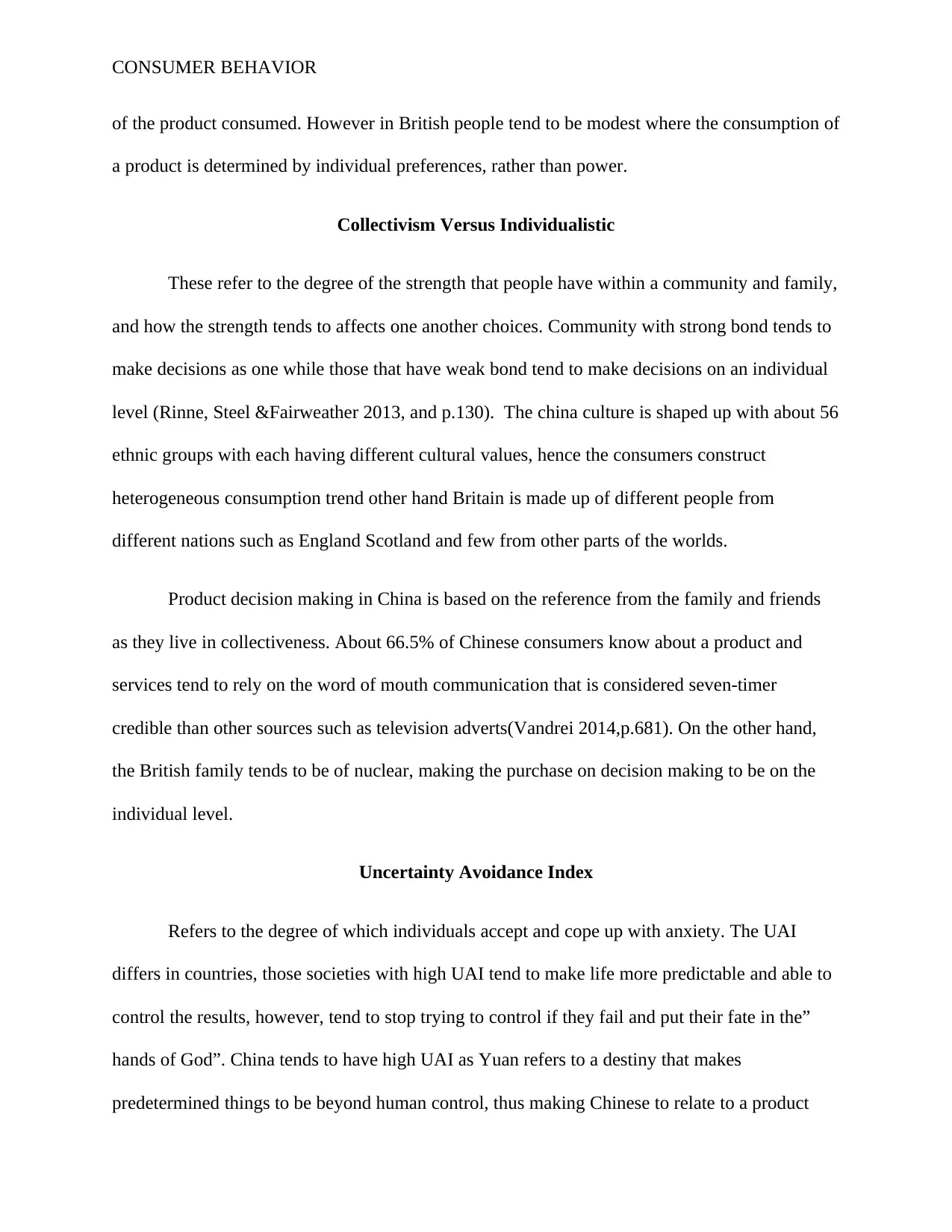
CONSUMER BEHAVIOR
of the product consumed. However in British people tend to be modest where the consumption of
a product is determined by individual preferences, rather than power.
Collectivism Versus Individualistic
These refer to the degree of the strength that people have within a community and family,
and how the strength tends to affects one another choices. Community with strong bond tends to
make decisions as one while those that have weak bond tend to make decisions on an individual
level (Rinne, Steel &Fairweather 2013, and p.130). The china culture is shaped up with about 56
ethnic groups with each having different cultural values, hence the consumers construct
heterogeneous consumption trend other hand Britain is made up of different people from
different nations such as England Scotland and few from other parts of the worlds.
Product decision making in China is based on the reference from the family and friends
as they live in collectiveness. About 66.5% of Chinese consumers know about a product and
services tend to rely on the word of mouth communication that is considered seven-timer
credible than other sources such as television adverts(Vandrei 2014,p.681). On the other hand,
the British family tends to be of nuclear, making the purchase on decision making to be on the
individual level.
Uncertainty Avoidance Index
Refers to the degree of which individuals accept and cope up with anxiety. The UAI
differs in countries, those societies with high UAI tend to make life more predictable and able to
control the results, however, tend to stop trying to control if they fail and put their fate in the”
hands of God”. China tends to have high UAI as Yuan refers to a destiny that makes
predetermined things to be beyond human control, thus making Chinese to relate to a product
of the product consumed. However in British people tend to be modest where the consumption of
a product is determined by individual preferences, rather than power.
Collectivism Versus Individualistic
These refer to the degree of the strength that people have within a community and family,
and how the strength tends to affects one another choices. Community with strong bond tends to
make decisions as one while those that have weak bond tend to make decisions on an individual
level (Rinne, Steel &Fairweather 2013, and p.130). The china culture is shaped up with about 56
ethnic groups with each having different cultural values, hence the consumers construct
heterogeneous consumption trend other hand Britain is made up of different people from
different nations such as England Scotland and few from other parts of the worlds.
Product decision making in China is based on the reference from the family and friends
as they live in collectiveness. About 66.5% of Chinese consumers know about a product and
services tend to rely on the word of mouth communication that is considered seven-timer
credible than other sources such as television adverts(Vandrei 2014,p.681). On the other hand,
the British family tends to be of nuclear, making the purchase on decision making to be on the
individual level.
Uncertainty Avoidance Index
Refers to the degree of which individuals accept and cope up with anxiety. The UAI
differs in countries, those societies with high UAI tend to make life more predictable and able to
control the results, however, tend to stop trying to control if they fail and put their fate in the”
hands of God”. China tends to have high UAI as Yuan refers to a destiny that makes
predetermined things to be beyond human control, thus making Chinese to relate to a product
Paraphrase This Document
Need a fresh take? Get an instant paraphrase of this document with our AI Paraphraser
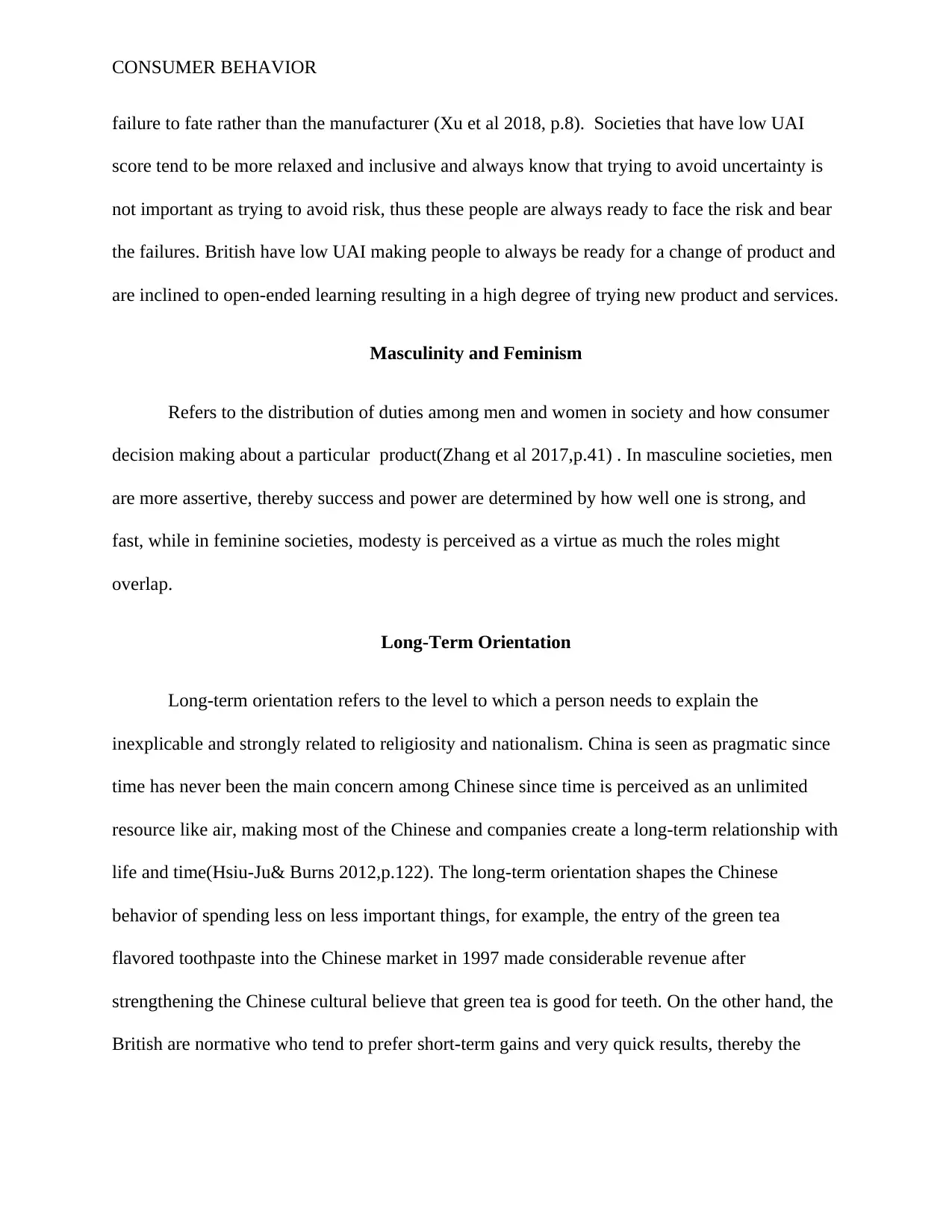
CONSUMER BEHAVIOR
failure to fate rather than the manufacturer (Xu et al 2018, p.8). Societies that have low UAI
score tend to be more relaxed and inclusive and always know that trying to avoid uncertainty is
not important as trying to avoid risk, thus these people are always ready to face the risk and bear
the failures. British have low UAI making people to always be ready for a change of product and
are inclined to open-ended learning resulting in a high degree of trying new product and services.
Masculinity and Feminism
Refers to the distribution of duties among men and women in society and how consumer
decision making about a particular product(Zhang et al 2017,p.41) . In masculine societies, men
are more assertive, thereby success and power are determined by how well one is strong, and
fast, while in feminine societies, modesty is perceived as a virtue as much the roles might
overlap.
Long-Term Orientation
Long-term orientation refers to the level to which a person needs to explain the
inexplicable and strongly related to religiosity and nationalism. China is seen as pragmatic since
time has never been the main concern among Chinese since time is perceived as an unlimited
resource like air, making most of the Chinese and companies create a long-term relationship with
life and time(Hsiu-Ju& Burns 2012,p.122). The long-term orientation shapes the Chinese
behavior of spending less on less important things, for example, the entry of the green tea
flavored toothpaste into the Chinese market in 1997 made considerable revenue after
strengthening the Chinese cultural believe that green tea is good for teeth. On the other hand, the
British are normative who tend to prefer short-term gains and very quick results, thereby the
failure to fate rather than the manufacturer (Xu et al 2018, p.8). Societies that have low UAI
score tend to be more relaxed and inclusive and always know that trying to avoid uncertainty is
not important as trying to avoid risk, thus these people are always ready to face the risk and bear
the failures. British have low UAI making people to always be ready for a change of product and
are inclined to open-ended learning resulting in a high degree of trying new product and services.
Masculinity and Feminism
Refers to the distribution of duties among men and women in society and how consumer
decision making about a particular product(Zhang et al 2017,p.41) . In masculine societies, men
are more assertive, thereby success and power are determined by how well one is strong, and
fast, while in feminine societies, modesty is perceived as a virtue as much the roles might
overlap.
Long-Term Orientation
Long-term orientation refers to the level to which a person needs to explain the
inexplicable and strongly related to religiosity and nationalism. China is seen as pragmatic since
time has never been the main concern among Chinese since time is perceived as an unlimited
resource like air, making most of the Chinese and companies create a long-term relationship with
life and time(Hsiu-Ju& Burns 2012,p.122). The long-term orientation shapes the Chinese
behavior of spending less on less important things, for example, the entry of the green tea
flavored toothpaste into the Chinese market in 1997 made considerable revenue after
strengthening the Chinese cultural believe that green tea is good for teeth. On the other hand, the
British are normative who tend to prefer short-term gains and very quick results, thereby the
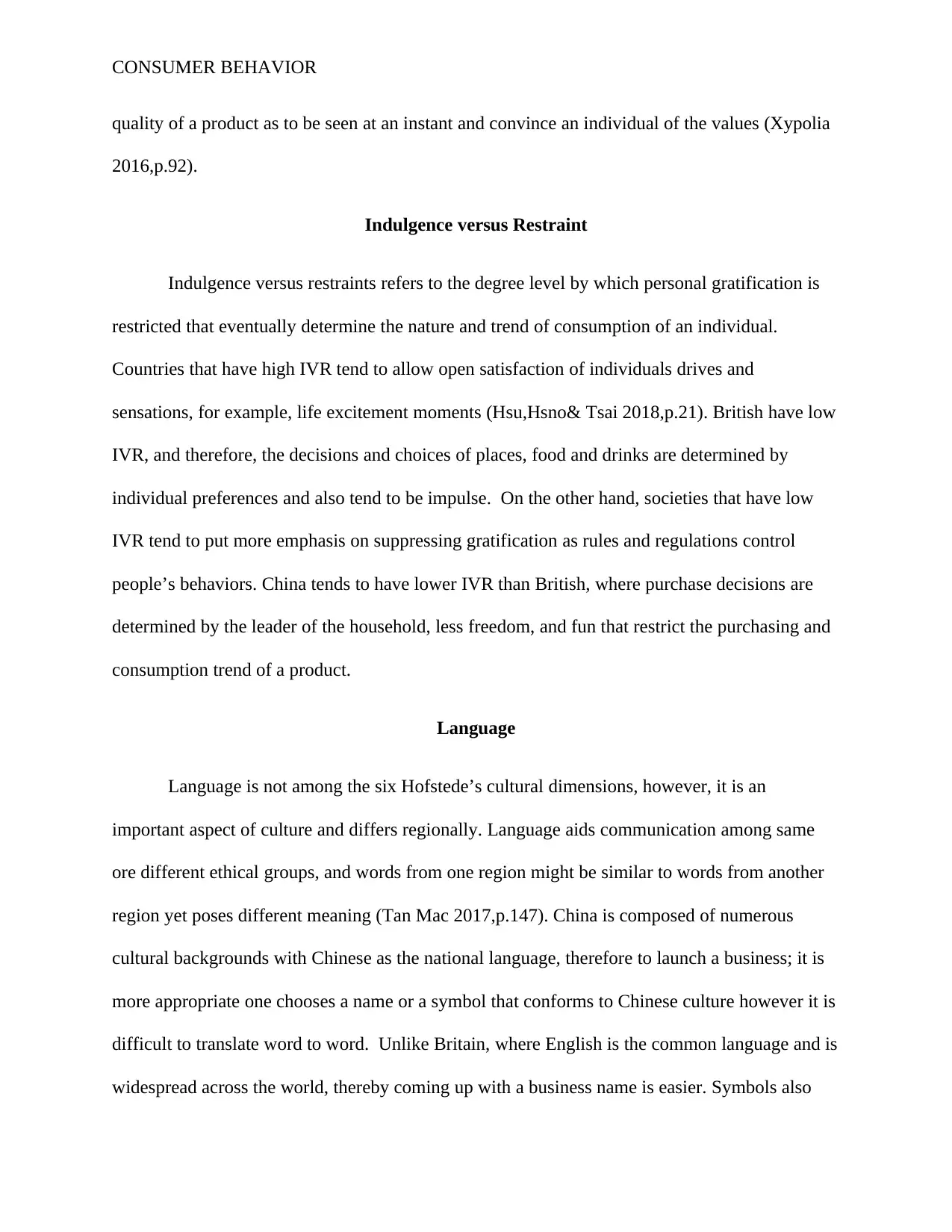
CONSUMER BEHAVIOR
quality of a product as to be seen at an instant and convince an individual of the values (Xypolia
2016,p.92).
Indulgence versus Restraint
Indulgence versus restraints refers to the degree level by which personal gratification is
restricted that eventually determine the nature and trend of consumption of an individual.
Countries that have high IVR tend to allow open satisfaction of individuals drives and
sensations, for example, life excitement moments (Hsu,Hsno& Tsai 2018,p.21). British have low
IVR, and therefore, the decisions and choices of places, food and drinks are determined by
individual preferences and also tend to be impulse. On the other hand, societies that have low
IVR tend to put more emphasis on suppressing gratification as rules and regulations control
people’s behaviors. China tends to have lower IVR than British, where purchase decisions are
determined by the leader of the household, less freedom, and fun that restrict the purchasing and
consumption trend of a product.
Language
Language is not among the six Hofstede’s cultural dimensions, however, it is an
important aspect of culture and differs regionally. Language aids communication among same
ore different ethical groups, and words from one region might be similar to words from another
region yet poses different meaning (Tan Mac 2017,p.147). China is composed of numerous
cultural backgrounds with Chinese as the national language, therefore to launch a business; it is
more appropriate one chooses a name or a symbol that conforms to Chinese culture however it is
difficult to translate word to word. Unlike Britain, where English is the common language and is
widespread across the world, thereby coming up with a business name is easier. Symbols also
quality of a product as to be seen at an instant and convince an individual of the values (Xypolia
2016,p.92).
Indulgence versus Restraint
Indulgence versus restraints refers to the degree level by which personal gratification is
restricted that eventually determine the nature and trend of consumption of an individual.
Countries that have high IVR tend to allow open satisfaction of individuals drives and
sensations, for example, life excitement moments (Hsu,Hsno& Tsai 2018,p.21). British have low
IVR, and therefore, the decisions and choices of places, food and drinks are determined by
individual preferences and also tend to be impulse. On the other hand, societies that have low
IVR tend to put more emphasis on suppressing gratification as rules and regulations control
people’s behaviors. China tends to have lower IVR than British, where purchase decisions are
determined by the leader of the household, less freedom, and fun that restrict the purchasing and
consumption trend of a product.
Language
Language is not among the six Hofstede’s cultural dimensions, however, it is an
important aspect of culture and differs regionally. Language aids communication among same
ore different ethical groups, and words from one region might be similar to words from another
region yet poses different meaning (Tan Mac 2017,p.147). China is composed of numerous
cultural backgrounds with Chinese as the national language, therefore to launch a business; it is
more appropriate one chooses a name or a symbol that conforms to Chinese culture however it is
difficult to translate word to word. Unlike Britain, where English is the common language and is
widespread across the world, thereby coming up with a business name is easier. Symbols also
⊘ This is a preview!⊘
Do you want full access?
Subscribe today to unlock all pages.

Trusted by 1+ million students worldwide
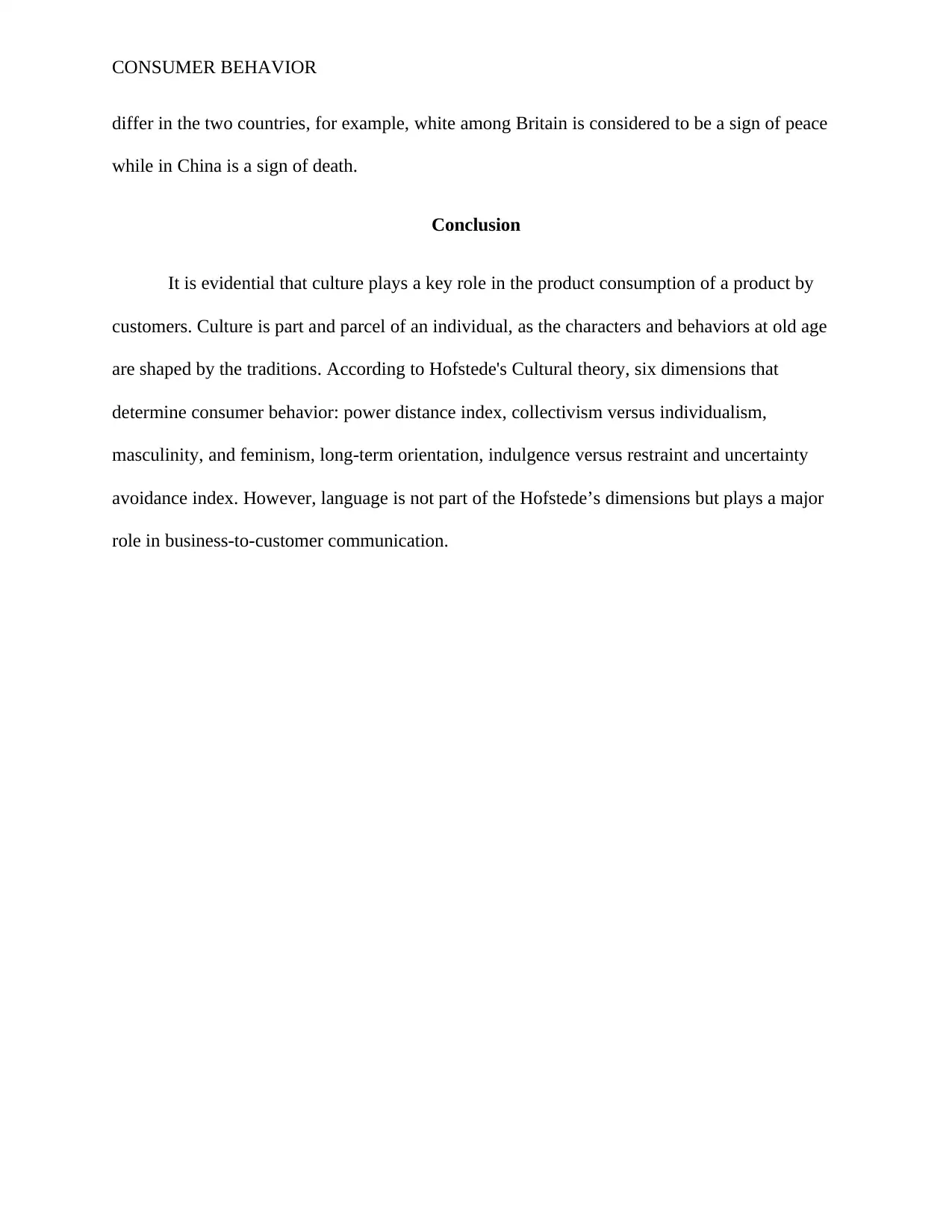
CONSUMER BEHAVIOR
differ in the two countries, for example, white among Britain is considered to be a sign of peace
while in China is a sign of death.
Conclusion
It is evidential that culture plays a key role in the product consumption of a product by
customers. Culture is part and parcel of an individual, as the characters and behaviors at old age
are shaped by the traditions. According to Hofstede's Cultural theory, six dimensions that
determine consumer behavior: power distance index, collectivism versus individualism,
masculinity, and feminism, long-term orientation, indulgence versus restraint and uncertainty
avoidance index. However, language is not part of the Hofstede’s dimensions but plays a major
role in business-to-customer communication.
differ in the two countries, for example, white among Britain is considered to be a sign of peace
while in China is a sign of death.
Conclusion
It is evidential that culture plays a key role in the product consumption of a product by
customers. Culture is part and parcel of an individual, as the characters and behaviors at old age
are shaped by the traditions. According to Hofstede's Cultural theory, six dimensions that
determine consumer behavior: power distance index, collectivism versus individualism,
masculinity, and feminism, long-term orientation, indulgence versus restraint and uncertainty
avoidance index. However, language is not part of the Hofstede’s dimensions but plays a major
role in business-to-customer communication.
Paraphrase This Document
Need a fresh take? Get an instant paraphrase of this document with our AI Paraphraser
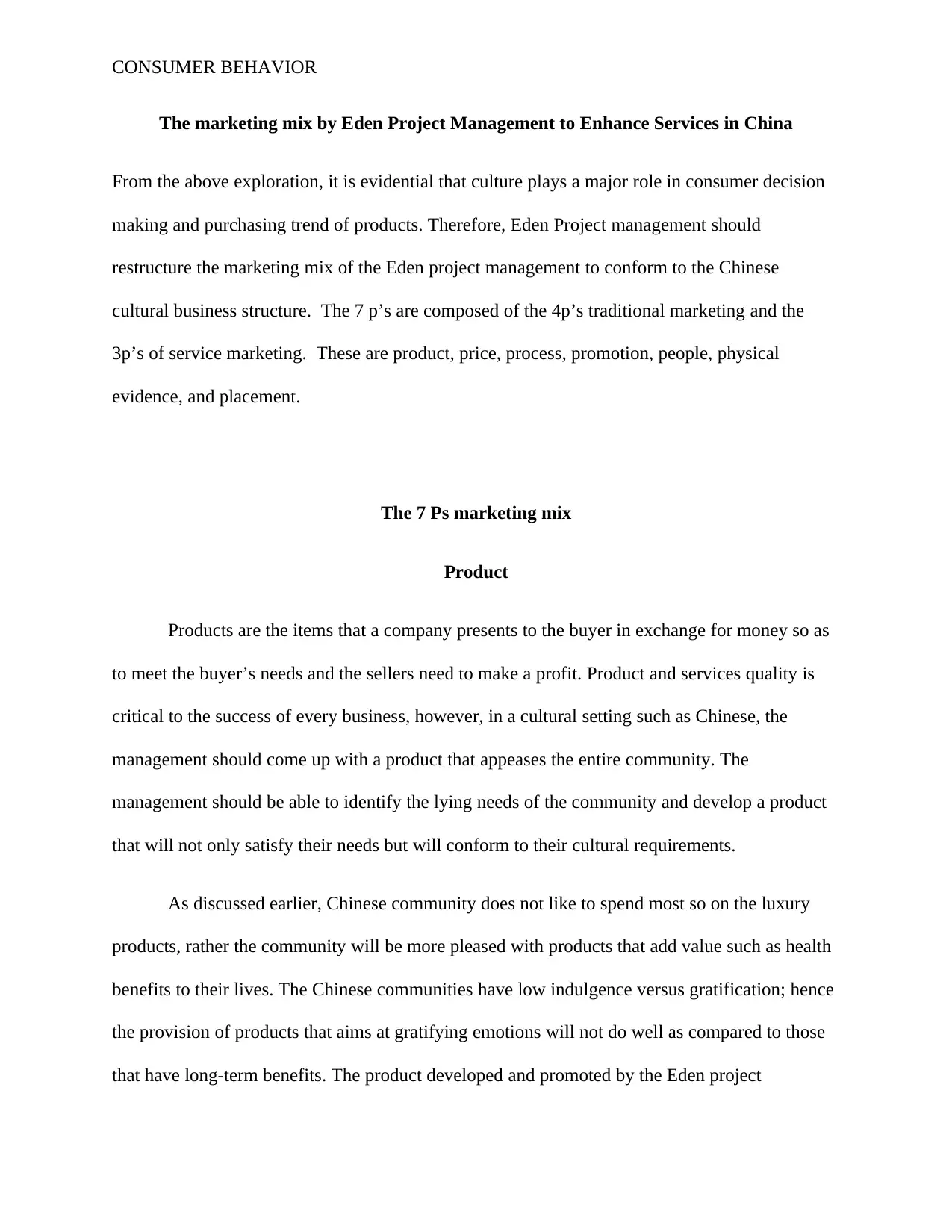
CONSUMER BEHAVIOR
The marketing mix by Eden Project Management to Enhance Services in China
From the above exploration, it is evidential that culture plays a major role in consumer decision
making and purchasing trend of products. Therefore, Eden Project management should
restructure the marketing mix of the Eden project management to conform to the Chinese
cultural business structure. The 7 p’s are composed of the 4p’s traditional marketing and the
3p’s of service marketing. These are product, price, process, promotion, people, physical
evidence, and placement.
The 7 Ps marketing mix
Product
Products are the items that a company presents to the buyer in exchange for money so as
to meet the buyer’s needs and the sellers need to make a profit. Product and services quality is
critical to the success of every business, however, in a cultural setting such as Chinese, the
management should come up with a product that appeases the entire community. The
management should be able to identify the lying needs of the community and develop a product
that will not only satisfy their needs but will conform to their cultural requirements.
As discussed earlier, Chinese community does not like to spend most so on the luxury
products, rather the community will be more pleased with products that add value such as health
benefits to their lives. The Chinese communities have low indulgence versus gratification; hence
the provision of products that aims at gratifying emotions will not do well as compared to those
that have long-term benefits. The product developed and promoted by the Eden project
The marketing mix by Eden Project Management to Enhance Services in China
From the above exploration, it is evidential that culture plays a major role in consumer decision
making and purchasing trend of products. Therefore, Eden Project management should
restructure the marketing mix of the Eden project management to conform to the Chinese
cultural business structure. The 7 p’s are composed of the 4p’s traditional marketing and the
3p’s of service marketing. These are product, price, process, promotion, people, physical
evidence, and placement.
The 7 Ps marketing mix
Product
Products are the items that a company presents to the buyer in exchange for money so as
to meet the buyer’s needs and the sellers need to make a profit. Product and services quality is
critical to the success of every business, however, in a cultural setting such as Chinese, the
management should come up with a product that appeases the entire community. The
management should be able to identify the lying needs of the community and develop a product
that will not only satisfy their needs but will conform to their cultural requirements.
As discussed earlier, Chinese community does not like to spend most so on the luxury
products, rather the community will be more pleased with products that add value such as health
benefits to their lives. The Chinese communities have low indulgence versus gratification; hence
the provision of products that aims at gratifying emotions will not do well as compared to those
that have long-term benefits. The product developed and promoted by the Eden project
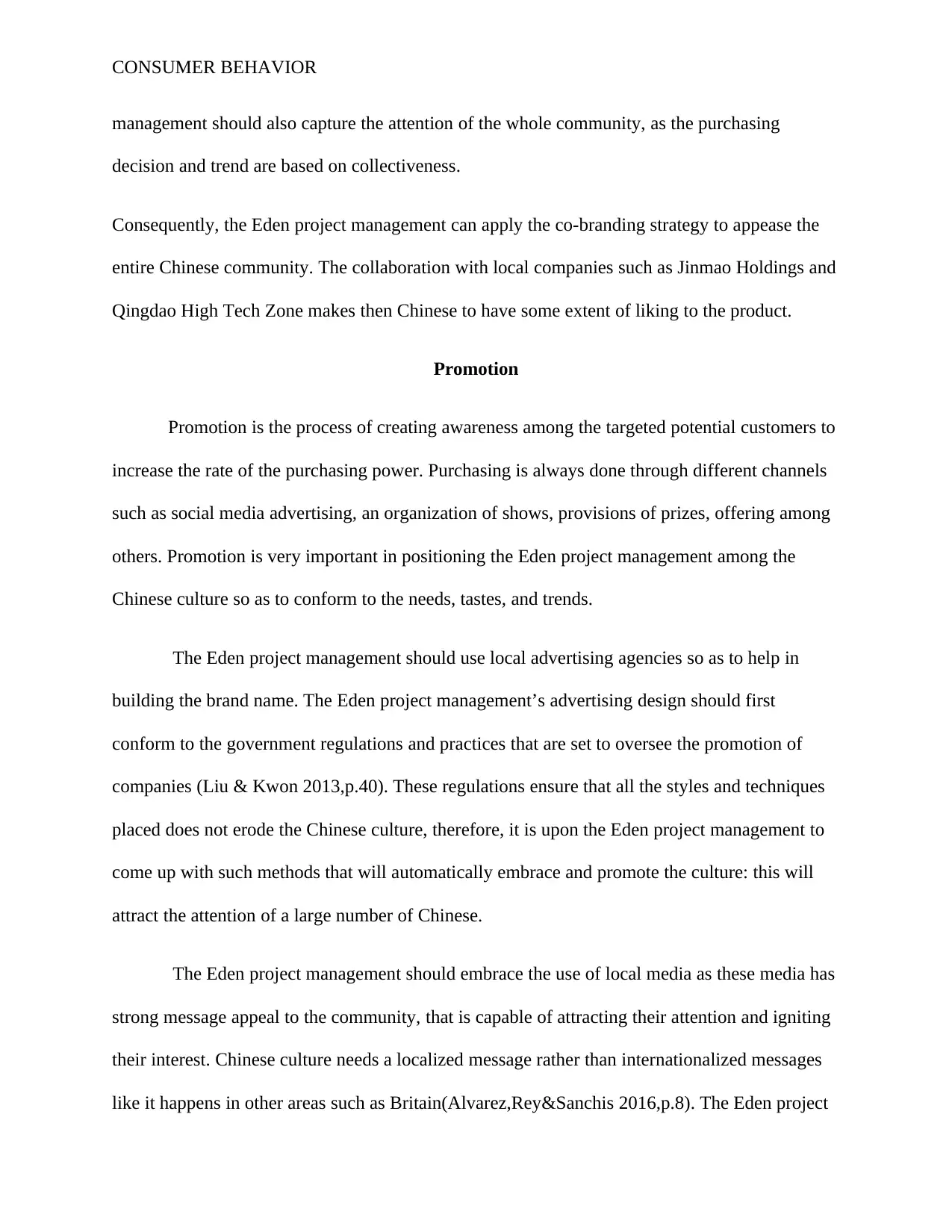
CONSUMER BEHAVIOR
management should also capture the attention of the whole community, as the purchasing
decision and trend are based on collectiveness.
Consequently, the Eden project management can apply the co-branding strategy to appease the
entire Chinese community. The collaboration with local companies such as Jinmao Holdings and
Qingdao High Tech Zone makes then Chinese to have some extent of liking to the product.
Promotion
Promotion is the process of creating awareness among the targeted potential customers to
increase the rate of the purchasing power. Purchasing is always done through different channels
such as social media advertising, an organization of shows, provisions of prizes, offering among
others. Promotion is very important in positioning the Eden project management among the
Chinese culture so as to conform to the needs, tastes, and trends.
The Eden project management should use local advertising agencies so as to help in
building the brand name. The Eden project management’s advertising design should first
conform to the government regulations and practices that are set to oversee the promotion of
companies (Liu & Kwon 2013,p.40). These regulations ensure that all the styles and techniques
placed does not erode the Chinese culture, therefore, it is upon the Eden project management to
come up with such methods that will automatically embrace and promote the culture: this will
attract the attention of a large number of Chinese.
The Eden project management should embrace the use of local media as these media has
strong message appeal to the community, that is capable of attracting their attention and igniting
their interest. Chinese culture needs a localized message rather than internationalized messages
like it happens in other areas such as Britain(Alvarez,Rey&Sanchis 2016,p.8). The Eden project
management should also capture the attention of the whole community, as the purchasing
decision and trend are based on collectiveness.
Consequently, the Eden project management can apply the co-branding strategy to appease the
entire Chinese community. The collaboration with local companies such as Jinmao Holdings and
Qingdao High Tech Zone makes then Chinese to have some extent of liking to the product.
Promotion
Promotion is the process of creating awareness among the targeted potential customers to
increase the rate of the purchasing power. Purchasing is always done through different channels
such as social media advertising, an organization of shows, provisions of prizes, offering among
others. Promotion is very important in positioning the Eden project management among the
Chinese culture so as to conform to the needs, tastes, and trends.
The Eden project management should use local advertising agencies so as to help in
building the brand name. The Eden project management’s advertising design should first
conform to the government regulations and practices that are set to oversee the promotion of
companies (Liu & Kwon 2013,p.40). These regulations ensure that all the styles and techniques
placed does not erode the Chinese culture, therefore, it is upon the Eden project management to
come up with such methods that will automatically embrace and promote the culture: this will
attract the attention of a large number of Chinese.
The Eden project management should embrace the use of local media as these media has
strong message appeal to the community, that is capable of attracting their attention and igniting
their interest. Chinese culture needs a localized message rather than internationalized messages
like it happens in other areas such as Britain(Alvarez,Rey&Sanchis 2016,p.8). The Eden project
⊘ This is a preview!⊘
Do you want full access?
Subscribe today to unlock all pages.

Trusted by 1+ million students worldwide
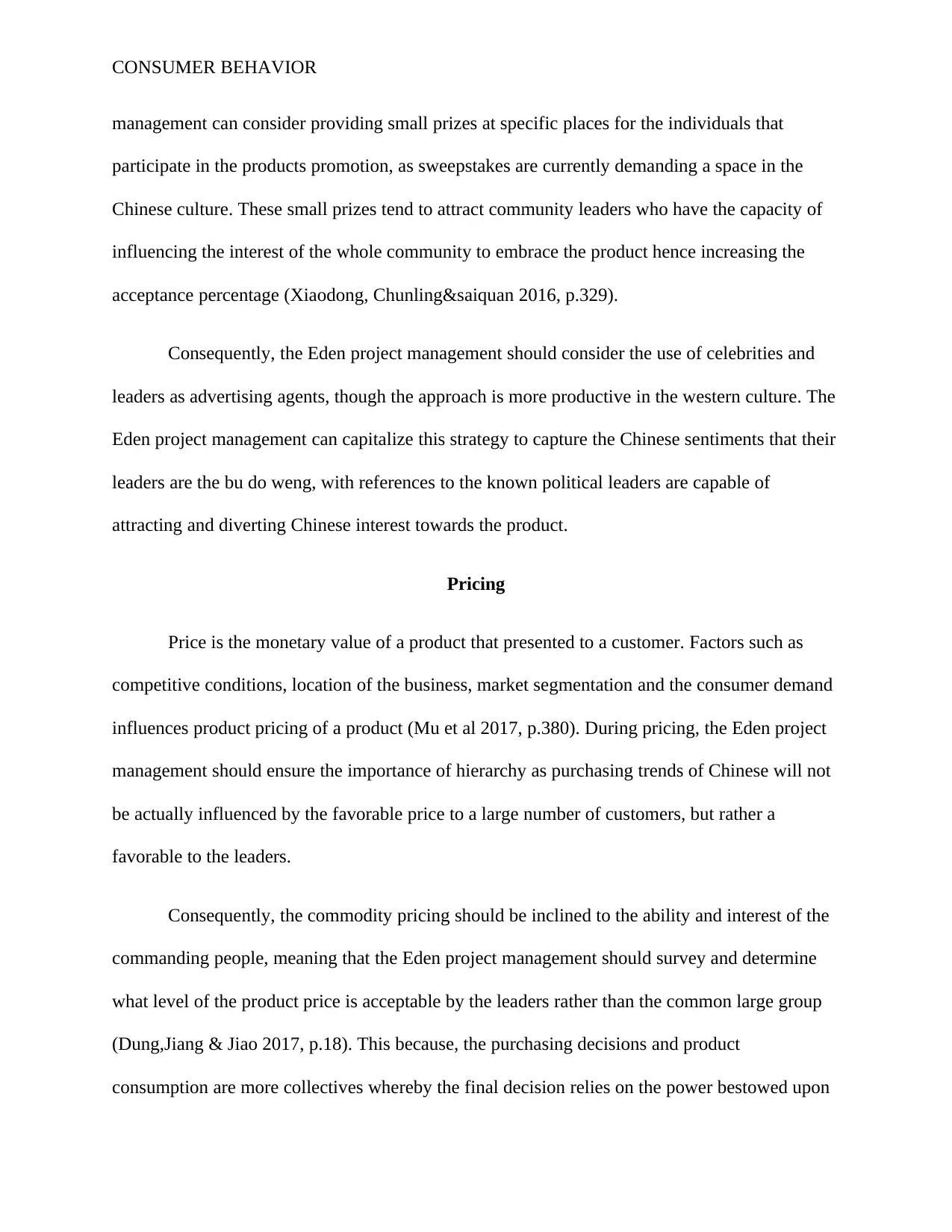
CONSUMER BEHAVIOR
management can consider providing small prizes at specific places for the individuals that
participate in the products promotion, as sweepstakes are currently demanding a space in the
Chinese culture. These small prizes tend to attract community leaders who have the capacity of
influencing the interest of the whole community to embrace the product hence increasing the
acceptance percentage (Xiaodong, Chunling&saiquan 2016, p.329).
Consequently, the Eden project management should consider the use of celebrities and
leaders as advertising agents, though the approach is more productive in the western culture. The
Eden project management can capitalize this strategy to capture the Chinese sentiments that their
leaders are the bu do weng, with references to the known political leaders are capable of
attracting and diverting Chinese interest towards the product.
Pricing
Price is the monetary value of a product that presented to a customer. Factors such as
competitive conditions, location of the business, market segmentation and the consumer demand
influences product pricing of a product (Mu et al 2017, p.380). During pricing, the Eden project
management should ensure the importance of hierarchy as purchasing trends of Chinese will not
be actually influenced by the favorable price to a large number of customers, but rather a
favorable to the leaders.
Consequently, the commodity pricing should be inclined to the ability and interest of the
commanding people, meaning that the Eden project management should survey and determine
what level of the product price is acceptable by the leaders rather than the common large group
(Dung,Jiang & Jiao 2017, p.18). This because, the purchasing decisions and product
consumption are more collectives whereby the final decision relies on the power bestowed upon
management can consider providing small prizes at specific places for the individuals that
participate in the products promotion, as sweepstakes are currently demanding a space in the
Chinese culture. These small prizes tend to attract community leaders who have the capacity of
influencing the interest of the whole community to embrace the product hence increasing the
acceptance percentage (Xiaodong, Chunling&saiquan 2016, p.329).
Consequently, the Eden project management should consider the use of celebrities and
leaders as advertising agents, though the approach is more productive in the western culture. The
Eden project management can capitalize this strategy to capture the Chinese sentiments that their
leaders are the bu do weng, with references to the known political leaders are capable of
attracting and diverting Chinese interest towards the product.
Pricing
Price is the monetary value of a product that presented to a customer. Factors such as
competitive conditions, location of the business, market segmentation and the consumer demand
influences product pricing of a product (Mu et al 2017, p.380). During pricing, the Eden project
management should ensure the importance of hierarchy as purchasing trends of Chinese will not
be actually influenced by the favorable price to a large number of customers, but rather a
favorable to the leaders.
Consequently, the commodity pricing should be inclined to the ability and interest of the
commanding people, meaning that the Eden project management should survey and determine
what level of the product price is acceptable by the leaders rather than the common large group
(Dung,Jiang & Jiao 2017, p.18). This because, the purchasing decisions and product
consumption are more collectives whereby the final decision relies on the power bestowed upon
Paraphrase This Document
Need a fresh take? Get an instant paraphrase of this document with our AI Paraphraser
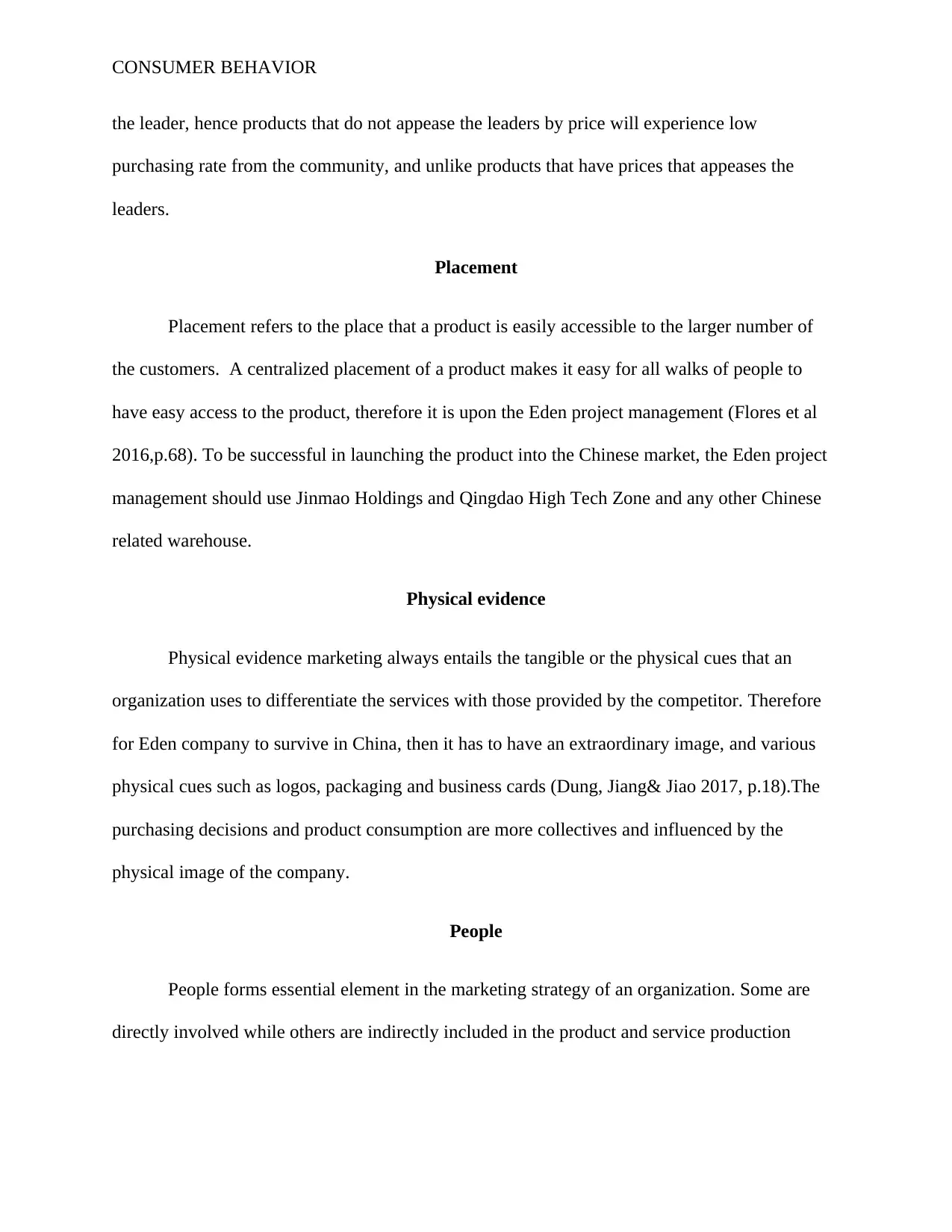
CONSUMER BEHAVIOR
the leader, hence products that do not appease the leaders by price will experience low
purchasing rate from the community, and unlike products that have prices that appeases the
leaders.
Placement
Placement refers to the place that a product is easily accessible to the larger number of
the customers. A centralized placement of a product makes it easy for all walks of people to
have easy access to the product, therefore it is upon the Eden project management (Flores et al
2016,p.68). To be successful in launching the product into the Chinese market, the Eden project
management should use Jinmao Holdings and Qingdao High Tech Zone and any other Chinese
related warehouse.
Physical evidence
Physical evidence marketing always entails the tangible or the physical cues that an
organization uses to differentiate the services with those provided by the competitor. Therefore
for Eden company to survive in China, then it has to have an extraordinary image, and various
physical cues such as logos, packaging and business cards (Dung, Jiang& Jiao 2017, p.18).The
purchasing decisions and product consumption are more collectives and influenced by the
physical image of the company.
People
People forms essential element in the marketing strategy of an organization. Some are
directly involved while others are indirectly included in the product and service production
the leader, hence products that do not appease the leaders by price will experience low
purchasing rate from the community, and unlike products that have prices that appeases the
leaders.
Placement
Placement refers to the place that a product is easily accessible to the larger number of
the customers. A centralized placement of a product makes it easy for all walks of people to
have easy access to the product, therefore it is upon the Eden project management (Flores et al
2016,p.68). To be successful in launching the product into the Chinese market, the Eden project
management should use Jinmao Holdings and Qingdao High Tech Zone and any other Chinese
related warehouse.
Physical evidence
Physical evidence marketing always entails the tangible or the physical cues that an
organization uses to differentiate the services with those provided by the competitor. Therefore
for Eden company to survive in China, then it has to have an extraordinary image, and various
physical cues such as logos, packaging and business cards (Dung, Jiang& Jiao 2017, p.18).The
purchasing decisions and product consumption are more collectives and influenced by the
physical image of the company.
People
People forms essential element in the marketing strategy of an organization. Some are
directly involved while others are indirectly included in the product and service production
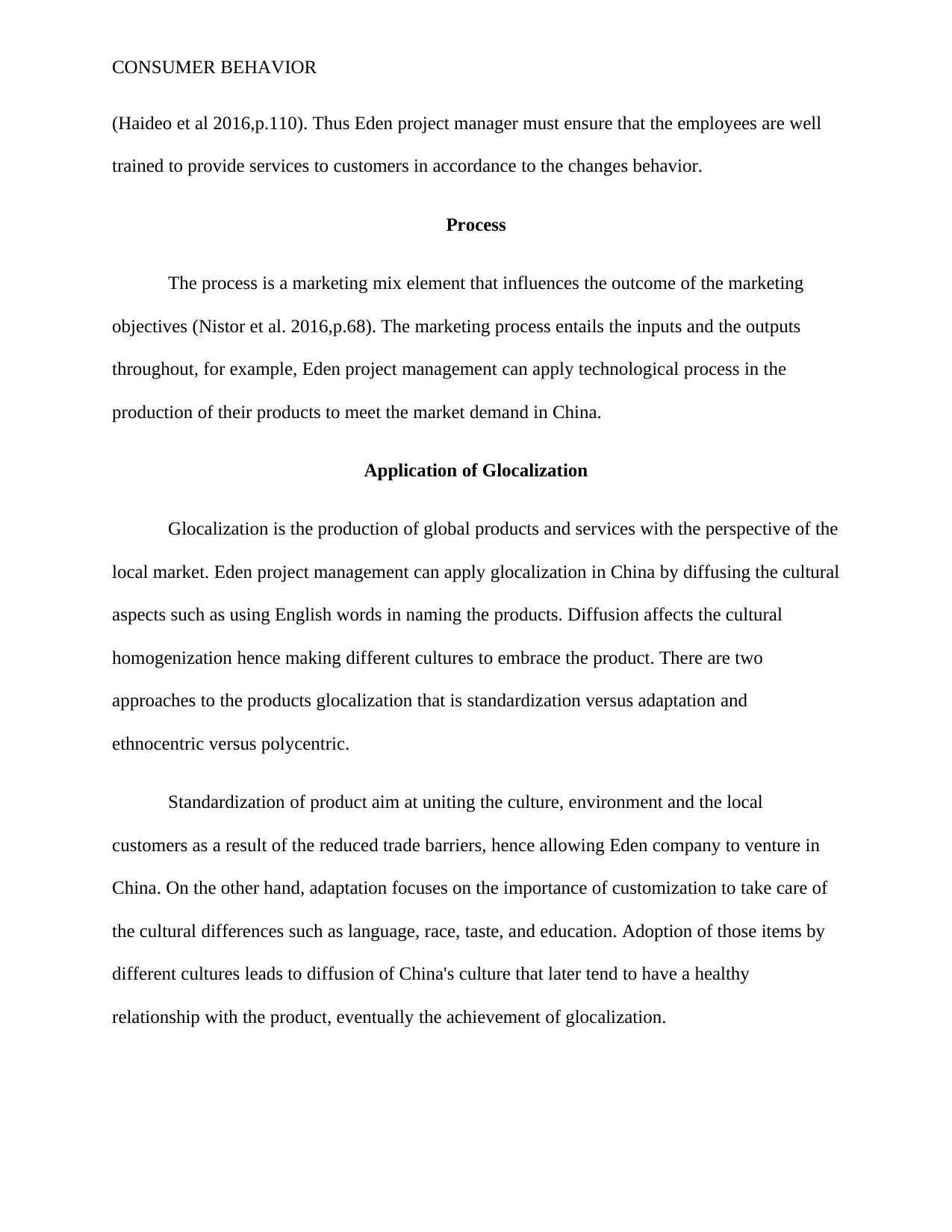
CONSUMER BEHAVIOR
(Haideo et al 2016,p.110). Thus Eden project manager must ensure that the employees are well
trained to provide services to customers in accordance to the changes behavior.
Process
The process is a marketing mix element that influences the outcome of the marketing
objectives (Nistor et al. 2016,p.68). The marketing process entails the inputs and the outputs
throughout, for example, Eden project management can apply technological process in the
production of their products to meet the market demand in China.
Application of Glocalization
Glocalization is the production of global products and services with the perspective of the
local market. Eden project management can apply glocalization in China by diffusing the cultural
aspects such as using English words in naming the products. Diffusion affects the cultural
homogenization hence making different cultures to embrace the product. There are two
approaches to the products glocalization that is standardization versus adaptation and
ethnocentric versus polycentric.
Standardization of product aim at uniting the culture, environment and the local
customers as a result of the reduced trade barriers, hence allowing Eden company to venture in
China. On the other hand, adaptation focuses on the importance of customization to take care of
the cultural differences such as language, race, taste, and education. Adoption of those items by
different cultures leads to diffusion of China's culture that later tend to have a healthy
relationship with the product, eventually the achievement of glocalization.
(Haideo et al 2016,p.110). Thus Eden project manager must ensure that the employees are well
trained to provide services to customers in accordance to the changes behavior.
Process
The process is a marketing mix element that influences the outcome of the marketing
objectives (Nistor et al. 2016,p.68). The marketing process entails the inputs and the outputs
throughout, for example, Eden project management can apply technological process in the
production of their products to meet the market demand in China.
Application of Glocalization
Glocalization is the production of global products and services with the perspective of the
local market. Eden project management can apply glocalization in China by diffusing the cultural
aspects such as using English words in naming the products. Diffusion affects the cultural
homogenization hence making different cultures to embrace the product. There are two
approaches to the products glocalization that is standardization versus adaptation and
ethnocentric versus polycentric.
Standardization of product aim at uniting the culture, environment and the local
customers as a result of the reduced trade barriers, hence allowing Eden company to venture in
China. On the other hand, adaptation focuses on the importance of customization to take care of
the cultural differences such as language, race, taste, and education. Adoption of those items by
different cultures leads to diffusion of China's culture that later tend to have a healthy
relationship with the product, eventually the achievement of glocalization.
⊘ This is a preview!⊘
Do you want full access?
Subscribe today to unlock all pages.

Trusted by 1+ million students worldwide
1 out of 18
Related Documents
Your All-in-One AI-Powered Toolkit for Academic Success.
+13062052269
info@desklib.com
Available 24*7 on WhatsApp / Email
![[object Object]](/_next/static/media/star-bottom.7253800d.svg)
Unlock your academic potential
Copyright © 2020–2025 A2Z Services. All Rights Reserved. Developed and managed by ZUCOL.





